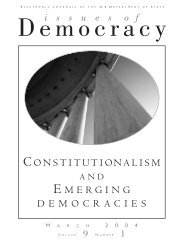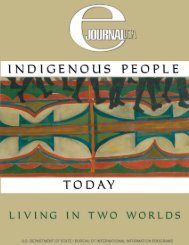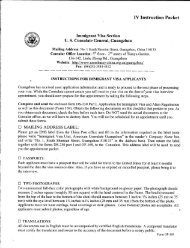s. history us history us history - Embassy of the United States
s. history us history us history - Embassy of the United States
s. history us history us history - Embassy of the United States
- No tags were found...
You also want an ePaper? Increase the reach of your titles
YUMPU automatically turns print PDFs into web optimized ePapers that Google loves.
CHAPTER 5: WESTWARD EXPANSION AND REGIONAL DIFFERENCESOUTLINE OF U.S. HISTORY“Go West, young man,and grow up with<strong>the</strong> country.”BUILDING UNITYThe War <strong>of</strong> 1812 was, in a sense,a second war <strong>of</strong> independence thatconfirmed once and for all <strong>the</strong>American break with England. Withits concl<strong>us</strong>ion, many <strong>of</strong> <strong>the</strong> serio<strong>us</strong>difficulties that <strong>the</strong> young republichad faced since <strong>the</strong> Revolutiondisappeared. National union under<strong>the</strong> Constitution brought a balancebetween liberty and order. With alow national debt and a continentawaiting exploration, <strong>the</strong> prospect <strong>of</strong>peace, prosperity, and social progressopened before <strong>the</strong> nation.Commerce cemented nationalunity. The privations <strong>of</strong> war convincedmany <strong>of</strong> <strong>the</strong> importance <strong>of</strong>protecting <strong>the</strong> manufacturers <strong>of</strong>America until <strong>the</strong>y could stand aloneagainst foreign competition. Economicindependence, many argued,Newspaper editor Horace Greeley, 1851was as essential as political independence.To foster self-sufficiency,congressional leaders Henry Clay <strong>of</strong>Kentucky and John C. Calhoun <strong>of</strong>South Carolina urged a policy <strong>of</strong> protectionism— imposition <strong>of</strong> restrictionson imported goods to foster <strong>the</strong>development <strong>of</strong> American ind<strong>us</strong>try.The time was propitio<strong>us</strong> for raising<strong>the</strong> c<strong>us</strong>toms tariff. The shepherds<strong>of</strong> Vermont and Ohio wanted protectionagainst an influx <strong>of</strong> Englishwool. In Kentucky, a new ind<strong>us</strong>try<strong>of</strong> weaving local hemp into cottonbagging was threatened by <strong>the</strong> Scottishbagging ind<strong>us</strong>try. Pittsburgh,Pennsylvania, already a flourishingcenter <strong>of</strong> iron smelting, was eager tochallenge British and Swedish ironsuppliers. The tariff enacted in 1816imposed duties high enough to givemanufacturers real protection.In addition, Westerners advo-cated a national system <strong>of</strong> roads andcanals to link <strong>the</strong>m with Eastern citiesand ports, and to open frontierlands for settlement. However, <strong>the</strong>ywere unsuccessful in pressing <strong>the</strong>irdemands for a federal role in internalimprovement beca<strong>us</strong>e <strong>of</strong> oppositionfrom New England and <strong>the</strong>South. Roads and canals remained<strong>the</strong> province <strong>of</strong> <strong>the</strong> states until <strong>the</strong>passage <strong>of</strong> <strong>the</strong> Federal Aid Road Act<strong>of</strong> 1916.The position <strong>of</strong> <strong>the</strong> federal governmentat this time was greatlystreng<strong>the</strong>ned by several SupremeCourt decisions. A committed Federalist,John Marshall <strong>of</strong> Virginiabecame chief j<strong>us</strong>tice in 1801 andheld <strong>of</strong>fice until his death in 1835.The court — weak before his administration— was transformedinto a powerful tribunal, occupyinga position co-equal to <strong>the</strong> Congressand <strong>the</strong> president. In a succession<strong>of</strong> historic decisions, Marshall established<strong>the</strong> power <strong>of</strong> <strong>the</strong> SupremeCourt and streng<strong>the</strong>ned <strong>the</strong> nationalgovernment.Marshall was <strong>the</strong> first in a longline <strong>of</strong> Supreme Court j<strong>us</strong>ticeswhose decisions have molded <strong>the</strong>meaning and application <strong>of</strong> <strong>the</strong>Constitution. When he finishedhis long service, <strong>the</strong> court had decidednearly 50 cases clearly involvingconstitutional issues. In one <strong>of</strong>Marshall’s most famo<strong>us</strong> opinions— Marbury v. Madison (1803) — hedecisively established <strong>the</strong> right <strong>of</strong> <strong>the</strong>Supreme Court to review <strong>the</strong> constitutionality<strong>of</strong> any law <strong>of</strong> Congress or<strong>of</strong> a state legislature. In McCulloch v.Maryland (1819), he boldly upheld<strong>the</strong> Hamiltonian <strong>the</strong>ory that <strong>the</strong>Constitution by implication gives<strong>the</strong> government powers beyondthose expressly stated.EXTENSION OF SLAVERYSlavery, which up to now had receivedlittle public attention, beganto assume much greater importanceas a national issue. In <strong>the</strong> early years<strong>of</strong> <strong>the</strong> republic, when <strong>the</strong> Nor<strong>the</strong>rnstates were providing for immediateor gradual emancipation <strong>of</strong> <strong>the</strong>slaves, many leaders had supposedthat slavery would die out. In 1786George Washington wrote that hedevoutly wished some plan mightbe adopted “by which slavery maybe abolished by slow, sure, and imperceptibledegrees.” Virginians Jefferson,Madison, and Monroe ando<strong>the</strong>r leading Sou<strong>the</strong>rn statesmenmade similar statements.The Northwest Ordinance <strong>of</strong> 1787had banned slavery in <strong>the</strong> NorthwestTerritory. As late as 1808, when <strong>the</strong>international slave trade was abolished,<strong>the</strong>re were many Sou<strong>the</strong>rnerswho thought that slavery wouldsoon end. The expectation provedfalse, for during <strong>the</strong> next generation,<strong>the</strong> South became solidly unitedbehind <strong>the</strong> institution <strong>of</strong> slavery asnew economic factors made slaveryfar more pr<strong>of</strong>itable than it had beenbefore 1790.Chief among <strong>the</strong>se was <strong>the</strong> rise <strong>of</strong>a great cotton-growing ind<strong>us</strong>try in<strong>the</strong> South, stimulated by <strong>the</strong> introduction<strong>of</strong> new types <strong>of</strong> cotton and112113












